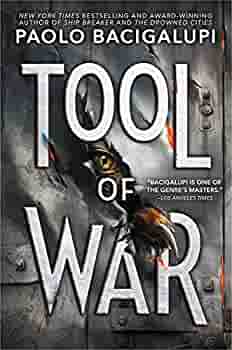
Paolo Bacigalupi’s Ship Breaker trilogy, which concludes with Tool of War, began as a disturbing ecological fable of young people trying to survive by mining ruined oil tankers for copper and other resources in a devastated southeastern US, mostly around New Orleans, then moved to an almost equally devastated DC area in The Drowned Cities. Over the course of the trilogy, though, the inundation of the coastlines began to serve mostly as background to the violent post-government society dominated by brutal corporations and even more brutal fiefdoms, religious cults, warlords, and criminal gangs. Tool, the superhuman “augment” who protected the youthful protagonists of Ship Breaker, was the only major character held over in The Drowned Cities, but he becomes the central figure in Tool of War, which, with the aid of a bit of plot addition, manages to reintroduce characters from both the previous novels, thus providing a conclusion that unites the three novels narratively as well as thematically. Tool (also called Blood, Blade, and Karta-Kul the Slaughter-Bringer) is a finely honed weapon, bred for massacre, survival, and loyalty. But after breaking free of his conditioned servitude, Tool represents a serious threat to his former masters, who attack with everything available in their considerable arsenal to destroy him lest they be forced to face the terrifying question of what happens when a weapon turns on its creators. For Tool was uniquely designed for more than just the tactical strategy and lethal bloodlust of most augments—he has a power that, now unleashed, could spell the end for a violently factionalized, inhumanly cruel humanity.
As he attempts to find his makers, Tool crosses paths again with friends from his past: Mahlia and her rag tag gang of “war maggots'' from The Drowned Cities are back, as are Nailer and Nita from Ship Breaker, tying the narrative of Tool of War neatly to the previous two books. It’s a fun element to this third book—seeing characters previously enjoyed returning as stronger, older and more developed people. The people who have mattered in Tool’s life are brought back to help him reach his own personal vendetta, and in doing so, attempt to change the world, if only just a little, if only for just a while. The narrative switches perspective between the characters, which allows the reader to see Tool’s story from a different perspective, and to question who or what he is—half human, half beast, warlord or soldier, weapon or protector.
Bacigalupi has been on point with choosing the half-man, half-monster augmented soldier Tool as the one character to tether the Ship Breaker trilogy to, because as much as the young adult characters of this series have been engaging, Tool has been the most complicated and so the most interesting. He isn’t the easiest to like, of course, but easy to empathize with, which makes him all the more provocative. Bacigalupi hasn’t bothered to make his characters likable—that’s not necessary when they are as raw as Tool, who is violent without fail, vicious and even unkind at times. Even to Nailer and Mahlia, who think of him as a friend, Tool has grown into something more, something frightening and volatile: “Now he seemed something else entirely. Not friend or ally. Something primal and unnerving. A nightmare out of humanity’s primeval past, a monster of old, a creature re-emerged from the darkest myths of protohumans, when jungles had never been razed, and when apes still cowered from darkness and struggled to master fire. A monster with its own interests and agenda.”
I rate this book a ⅘ stars because I wasn’t entirely educated on the trilogy because I read the third book of the series with summaries on the first two. I highly encourage you to read the first two books, Ship Breaker and Drowned Cities, before Tool of War so you can have a better understanding of the series as you cruise through the finale. That said, I still enjoyed this book because of its immense detail and central topic, even though it was a bit lengthy.
